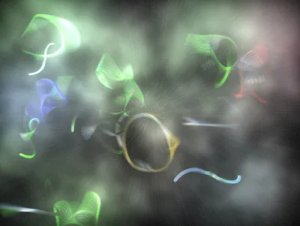
Quantum thinking and the new vision of the cosmos
Quantum physics has come to deal with ideas of matter and energy very differently from what we inherited from classical physics. By looking at subatomic scales and situations such as tunneling and wormholes, our intuitions and ways of thinking about nature, reality and spirituality change profoundly.
differently from what we inherited from classical physics. By looking at subatomic scales and situations such as tunneling and wormholes, our intuitions and ways of thinking about nature, reality and spirituality change profoundly.
Much of our thinking is still tied to the idealistic view of matter and energy, and the observations of the James Webb megatelescope seem to go further, suggesting string theory (a new view of matter as “vibration”) and the information paradox of black holes (in fact, information is not lost there, but something “escapes” from its imprisonment).
Although the Standard Physics model established the main unification of subatomic particles, and the discovery of the Higgs boson in the CERN experiment was a fundamental step, explanations of dark matter and black holes still remained.
String theory (picture above) is one of the main candidates for this unification, as it presents a connection between the fundamental forces of the cosmos.
The central problem is the unification of Einstein’s theory of relativity and quantum physics, which has many issues already resolved, such as the EPR phenomenon, named after the article by Einstein, Podolski and Rosen, who disputed the “ghostly” effect of energy, whose mathematical equation is called Bell’s Inequality, a problem that establishes that it would be impossible to have the same measurement result in two parts of a quantum system, regardless of the distance separating the two parts, in 2022 Alain Aspect wins the Nobel Prize for proving this.
The principles of special relativity state that information cannot be transmitted faster than the speed of light, so an equal effect “at any distance” would be ghostly and this calls into question the principle of quantum behavior without distance.
Since the theory of general relativity cannot explain the Big Bang theory, nor the behavior of black holes, Stephen Hawking created a theory called the Information Paradox, which proposed mathematically that information escapes the voracity of black holes.
Hawking’s idea was just the idea of thermal radiation, or heat escaping, but it doesn’t carry any information about the origin of the black hole or the matter it swallowed.
String theory was developed in an attempt to unify these two main theories of modern physics. It was first proposed in 1919 by Theodor Kaluza, then there was an innovation by Edward Witten between 1994 and 1997 and now something that is being called quantum “hair”, where information escapes from black holes.
The idea of hair arose from its winter, physicist John Wheeler saying that black holes have no distinctive features, no ‘hairstyle’, ‘cut’ or ‘color’ to differentiate them.
However, Calmet and others, in a 2022 article entitled “Quantum Hair from Gravity”, discovered that black holes can indeed “have hair”, albeit very subtle, and in 2023 they went a step further by showing evidence of its creation in black holes.
Initially we changed our view of space and time, then our view of matter and particle, now we have found something deeper that the universe does not lose any information, mathematical calculations and cosmic observations are complex, but we are getting closer and closer to dismantling the idealistic edifice of physical and real dualism.
Calmet, Xavier; Casadio, R.; Hsu, Stephen D.H.; Kuipers, Folkert. (2022) Quantum Hair from Gravity. Phys. Rev. Lett. 128.
Calmet, Xavier; Hsu, Stephen D.H.; Sebastianutti; M. (2023) Quantum gravitacional to particle creation by Black holes. Physics Letter B 841.









